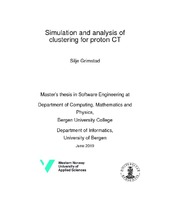Simulation and analysis of clustering for proton CT
Master thesis
Permanent lenke
https://hdl.handle.net/1956/20857Utgivelsesdato
2019-06-29Metadata
Vis full innførselSamlinger
Sammendrag
A research team in Bergen in collaboration with others is working to develop a proton Computed Tomography (pCT) prototype. It is an image modality that uses proton rather than x-ray to create a CT-image. This can lead to a more precise dose calculation when used in proton therapy. The proton CT system uses a Digital Tracing Calorimeter (DTC) consisting of multiple layers of ALPIDE chips with the aim of measuring where the protons stops in the calorimeter. The objective of this thesis is to simulate particle hits on a single ALPIDE chip using a realistic data collection of pixel cluster shapes and then use different approaches to reconstruct the clusters. The challenge when reconstructing the clusters is to find a satisfying approach to separate the overlapping clusters. The reconstruction was done by experimenting with various cuts, which had different ways to distinguish abnormal clusters. The basic method was a template for all the cuts when reconstructing clusters. 3 different cuts were tested: fill percentage cut, asymmetric cut and inactive pixels cut. The different cuts had various parameters to optimise in order to improve the percentage of perfectly reconstructed clusters. The optimal cut, based on the cuts tested in this thesis, was divided into 3 parts. These include the optimal solution for 0-100 clusters, 100-300 clusters and 300-500 clusters, respectively, in the detector. The inactive pixels cut had the most perfectly reconstructed clusters in the first part. The optimal cut for the second part, based on the selected parameters, was inactive pixels combined with fill percentage. The third optimal cut, for 300-500 clusters, was the asymmetric cut combined with fill percentage cut. The third optimal cut can have up to approximately 350 clusters in the detector to obtain at least 96% perfectly reconstructed clusters.
